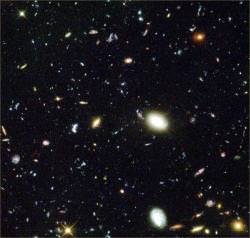Dark energy is that mysterious force that seems to be accelerating the expansion of the Universe. But the question is: has it always been pushing the Universe apart with the same force, or was it weaker or stronger in the past, and will it get stronger in the future? Researchers from the Harvard-Smithsonian Center for Astrophysics have a plan to study distant clumps of hydrogen, to get to the bottom of this question, once and for all.
Dark energy was first discovered nearly a decade ago, when astronomers noticed that distant supernovae were further away than their calculations were expecting. Some mysterious force appears to be accelerating the expansion of the Universe from every point in space. As space expands, more dark energy seems to appear. And although the amount of dark energy in any one point in space is tiny, across the vast reaches of space, it really adds up, accounting for more than 70% of the Universe.
If dark energy is increasing, however, you could imagine it eventually becoming so strong that it starts to tear galaxy clusters apart, and then galaxies themselves, and even star systems. Maybe it might even become so strong that it tears apart atoms and even the fabric of space itself. Astronomers call this theory the “Big Rip”. Or maybe just the opposite is true, and dark energy will eventually become negligible to the expansion of the Universe.
In order to see if the strength of dark energy is changing over time, astronomers are planning to carefully plot the position of clouds of neutral hydrogen, shortly after they formed from the Big Bang. Although it’s not possible now, future planned observatories should be able to trace this material all the way back to a time when the Universe was only 200 million years old.
In the early Universe, small fluctuations in energy density and pressure caused oscillations. Although tiny in the beginning, these ripples have been magnified by the expansion of the Universe so that they stretch 500 million light-years across today. The clouds of neutral hydrogen should follow the same ripple pattern, so astronomers will know they’re looking at those first, primordial clouds, and not some closer ones.
And so, astronomers will be able to look back in time, and study the distance to the clouds at each epoch in our Universe’s expansion. They should be able to trace how much dark energy was affecting space at each time, and get a sense if this energy has always remained constant, or if it’s changing.
Their answers will shape our understanding of the Universe’s evolution, and its future.
Original Source: CfA News Release


It is my opinion that as we have now encountered dark energy, it would be atavistic, to presume that we alone occupy the universe.
That is, we should now hazard a guess that there are constraints on how the rate of expansion behaves due to earlier or later big bangs having taken place.
Using this conjecture It would be prudent to assume that many, many more big-bangs ante-date our very own, than have post-dated our local big bang.
Hence, the rate of expansion of our dark energy is likely to be essentially uniform in a conglomeration that is awaiting the onset of our big-bang. – JimEJD
Dark energy is the Cosmic Microwave Background Radiation. The overall Electromagnetic Field.
The accelerating expansion must have a constant force to pay for it. Otherwise there would not be an acceleration
This force by necessecity must be greater than the entire energy of our Universe because everything is being effected by it.
Therefore the force must be coming from outside.
We are being streached from the outside. Not being pushed by some mysterious force from the inside.
Our Universal globule of Electromagnetic Energy is at a higher density potential than the non-region I call the Big Nothing that we are expanding into.
The Big Nothing is at a density of close to zero. Therefore the potential difference causes us to expand into it.
Everything is a matter of scale:
Tony Trento
a density of close to zeron
is nothing compared to magnetizm.
You won’t be pulled apart, don’t worry
The article regarding Dark Energy is very interesting and apparently honest with its use of certain words. Specifically:
o Dark energy is PROBABLY
o Scientists have ABSOLUTELY NO IDEA
o cosmologists at Durham University MIGHT.
Until scientists can be more positive about dark energy and dark matter, then it remains in the category of — maybe.
Consider a bubble or ballon rising in a liquid.As it nears the surface, it’s rate of expansion increases,not due to increased internal pressure, but rather to a decrease in external pressure, similar to the hypothesis above by Tony T.
Will the bubble eventually break the surface and explode(Great Rip), or simply form a stable hemisphere on the “surface”?
My 2Cents worth.
Do we really need dark energy? What if there were several big bangs and distant galaxies from our area are being attracted by the universes created by other big bangs? And if we cannot detect objects beyond those created since our big bang, we cannot detect other universes.